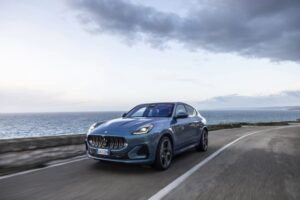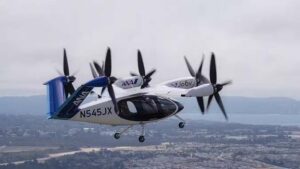Verge Motorcycles CEO Tuomo Lehtimäki joined EV Powered to discuss the benefits of staying quiet in the EV startup world, the advantages of in-wheel motors, and why society is shifting toward electric motorcycles.
The EV startup world can be full of shouting and empty promises – just like regular tech startups. Cast your mind back over the last decade. Brands like Faraday Future, Lordstown Motors, and Lightning Car Company talked big but delivered little.
A quick Google search of "failed EV companies" throws up these names and several more.
While Rimac and Tesla have been grabbing headlines with Formula 1-beating top speeds and unhinged political tweets, Verge Motorcycles has quietly been redefining what an electric motorcycle should be. Verge has been at it since 2018, but you wouldn’t know because they’re from Finland.
Finns don’t do mouthy.
Multi-Million Dollar Success Story
To discuss what’s made this "very Finnish" manufacturer the multi-million-dollar success story it is today, EV Powered caught up with CEO Tuomo Lehtimäki. Like many of his compatriots – both in and out of the automotive world – Lehtimäki is far from self-praising about Verge’s achievements. He’s cut from similar cloth to Mate Rimac rather than Elon Musk.
Yet Verge’s achievements are plenty.
Over its short life, Verge Motorcycles has collaborated with two-time F1 champion Mika Häkkinen on a 100-strong limited edition run of bikes. They’ve also brought on board motorsport’s favorite mullet, Valtteri Bottas, as brand ambassador.
"We’re proud to be a Finnish company, but we Finns never think too highly of ourselves," Lehtimäki says. "While Mika and Valtteri definitely have inspired us with their achievement and we’re happy to have them involved, that’s not everything."
“In Finland, we’re definitely an engineering country with an engineering mindset, but we’re always thinking about how the rest of the world sees us. At Verge, we want to be this super focused company dedicated to changing firstly, powertrains on electric motorcycles, and secondly, the EV motorcycle industry as a whole.”
Guinness World Record
Considering what Verge has already done to disrupt the electric motorcycle world, it would be foolish to question Lehtimäki’s vision. He’s an energy systems engineer after all.
Earlier this year, the brand rode into the history books. In March, its Verge TS Pro covered 193 miles on a single charge – a new Guinness World Record for an electric motorcycle.
Like other models in the Verge range – the TS Ultra and California Edition – the TS Pro is driven by a distinctive in-wheel motor. It produces 138bhp and a staggering 738lb ft of torque.
The innovative motor choice is just one part of the bike’s genius.
"The biggest advantage of an in-wheel motor is that it has around 120 fewer moving parts than if you use a conventional unit," explains Lehtimäki. "Fewer parts means your production costs are reduced by a few thousand euros or dollars."
From a rider’s perspective, an in-wheel motor means better control over the bike.
“The valves in the motor let you know exactly where the wheel is positioned on the road. If we’re relying on chains or belts, then you just know the position of the motor. As to where the wheel is? That’s guesswork.”
In-Wheel Technology Benefits
When it comes to proponents of in-wheel technology in the car world, Bedeo is already applying it. The Renault 5 Turbo 3E hyperhatch will adopt this layout. The upcoming Alpine A110 and rumored Volkswagen ID.2 R are also expected to do so.
As well as looking villainously cool and providing better riding experience than regular drivetrains, Lehtimäki reveals that the in-wheel motor lends itself to better battery performance. Another of Verge’s points of pride is what he describes as a "structural battery."
If you don’t speak engineer, this translates to "the battery is part of the bike’s frame."
In the case of the TS Pro, which costs £20 short of £32,000, it packs an in-house made 20.2kWh battery producing 217 miles of range. While the battery is the same size as the one used in the pioneering VW e-Golf, the two-wheeler will travel around 20 miles further.
Meanwhile, Verge’s flagship TS Ultra has a single-charge range of 233 miles.
Range and Charging
All Verge motorcycles come with AC and fast-charging DC capabilities courtesy of the Tesla charging port.
“By the time you’ve had a leak and a coffee, you can charge from 0 to 80% in just 35 minutes.”
Given the bikes’ compatibility with the Tesla Supercharger network, that’s not wrong.
Does Lehtimäki feel that 217 or 233 miles worth of charge is too much? As well as outdoing the e-Golf, this is more than other future classic EVs like the Honda e and Nissan Leaf. It’s even more than some newer cars including the Dacia Spring and Leapmotor T03.
"Honestly, I think we’ve hit our peak," he reveals. "100 kilometers isn’t really enough because once you’ve done 40 kilometers, you have to turn back and go home. Some people accept that 200km is good, but we wanted to offer a versatile portfolio of bikes you can use in the city, and on a ride out with your family or friends."
“If we start going beyond a 300km range for crazy traveling and stuff, that’s when it becomes a specialist product. That would also affect the price point of our product.”
Future of Electric Motorcycles
Despite his passion for the company he founded, Lehtimäki remains the stereotypical Finn in his pragmatic outlook on the electric motorcycle landscape.
Given what Verge has achieved and will likely go on to do, it would be easy for him to indulge in self-aggrandizing statements about changing the world. But like I said earlier, Finns don’t lend themselves to that sort of thing.
"I think it’s going to be a gradual shift to get everyone onside, but we’ve definitely shaken up some people’s way of thinking with how we lay our bikes out and what we’ve done in terms of tech," he says. "What changed everything for us though, was the charging network."
Even in 2019, there was nowhere to charge an electric car or motorcycle – now charging ports are everywhere.
Looking to the future, Lehtimäki thinks the shift to electric motorcycles will be like smoking – hardly anybody smokes these days because it’s not cool. But that pressure came from authority.
Another way of seeing the transition is by looking at it like mobile phones.
“You see a friend, a public figure, or someone you look up to and they have a new iPhone or whatever, and you’re stuck with your old Motorola. Then you want the same phone as them.”
"In electric motorcycle terms, that’s my wild guess about what will happen, because you think you’ll be seen as a bit stupid for not riding electric – it all boils down to societal pressure. Then this avalanche starts, and you can’t stop it."
In fact, he thinks it’s already started.
Room for Both
To wrap up, Lehtimäki shares the opinion voiced by The Late Brake Show’s Jonny Smith in a recent interview he gave to EV Powered. It’s possible to enjoy both ICE and electric powertrains.
"I’m very open when I say that nobody should feel bad about riding a gasoline bike," the Finn concludes. "I love Harley-Davidsons, but I’m not really sure I should buy any more."
You can have your electric bike for around town because it’s nice and quiet. You can have your four-stroke for messing about with at the weekend.
“It’s not a one-size-fits-all solution and for now there is definitely room for both… but the world is changing, one bike at a time.”





